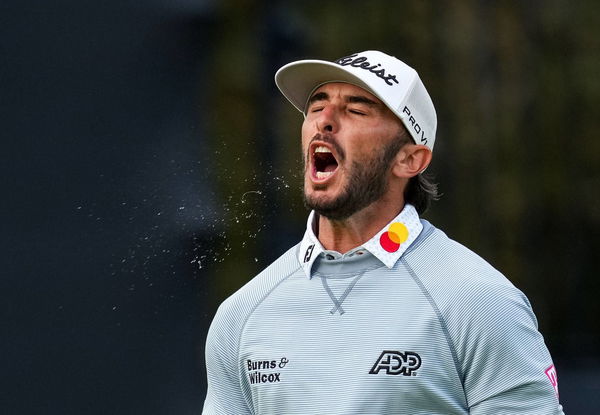
via Imago
Scottie Scheffler & Max Homa. Credit: IMAGO

via Imago
Scottie Scheffler & Max Homa. Credit: IMAGO
Even for golfers who spend their lives in the margins between brilliance and heartbreak, some moments sting more than most. Moments where the dream seems within reach, and then breaks, suddenly, unexpectedly. Max Homa, a six-time PGA Tour winner, knows this well. In a recent YouTube video from Grant Horvat entitled “Can I Beat Max Homa if I Start 5 Under Par?”, he recalled one of those moments: playing alongside Scottie Scheffler at the Masters, leading after two rounds, only to have a single shot unravel the rest.
Watch What’s Trending Now!
Grant Horvat, in challenging Homa to a match and referencing seeing him at the Masters “like two years ago,” nudged open a door for this memory. Homa, keen to share, transported us back to Augusta National, a place of rich heritage, unforgiving greens, and the weight of legends. He had made his way into contention. “Yeah, me, Tiger, and Jason. That was as fun as it gets. I was leading after two days. Endo getting third. I had Scotty. I got the worst break of my entire career on 12. I remember this 11 was playing as hard as I could ever remember and I hit one of the best six-irons of my life and then Scotty made bogey.”
Then came the moment that changed it all. On 12, he faced a scary shot. Thick rough, bunker, shadowing, it was a shot that demanded full execution. He aimed over the bunker, committed. He drove a nine-iron, and for a second, he thought: “Holy, I did it.”
ADVERTISEMENT
Article continues below this ad
A moment later, it all came crashing down, Homa added, “I would have made probably bogey, but it’s between it and this little strip of ivy. We barely found the ball and I thought it flew back there. Like me and my caddyy were kind of sick, Joe. We like couldn’t believe it. Yeah. And when we watched the video back, it landed on the fringe and hit like a rocket ship and bounced up into the ivy. I made double and then had literally no chance.” It just sucks that, like you said, ‘you live for it, and you I pulled it’. I did exactly what I was trying to do. Yeah. And it just got jettisoned.”

via Imago
Max Homa reacts after making the cut of 7 over par by holing a birdie putt on the 18th green. The British Open Championship, Day Two, Golf, Royal Troon, Troon, UK – 19 July 2024 PUBLICATIONxINxGERxSUIxAUTxHUNxGRExMLTxCYPxROUxBULxUAExKSAxONLY Copyright: xStuartxWallace/Shutterstockx 14588002dg
On hole 11, he hit “one of the best six-irons” of his life. Scheffler, playing just behind him, eventually made a bogey. That put Homa one or two behind, meaning he was in the mix. On 12, he faced the scary shot. He drove a nine-iron, and for a second, he believed he was going to land in the middle of the green, two-putt, and still have six holes to beat Scheffler and take the Masters. But the ball took a cruel bounce. It landed on the fringe, hit hard, then bounced backward into the ivy between the bunker and the bushes. He and his caddie searched; they found it, but by then the damage was done. He made a double bogey.
ADVERTISEMENT
Article continues below this ad
Despite this collapse on 12, despite a double that likely cost him the Masters in that year, Homa has continued to compete at a high level. He has built a reputation not just for his ball-striking, but for being emotionally intelligent on the course: managing swings, handling bad breaks, fighting to stay in the match even when things go sideways. Homa’s story with Scheffler at Augusta is more than an anecdote. It’s a reminder that even at the highest levels, the game can turn on one bounce, one shadow, one leaf of ivy. And perhaps that’s what gives its victories so much weight, and its losses so much sting.
While Homa’s hopes unraveled with that cruel bounce on 12, Scottie Scheffler quietly showed the opposite side of Augusta’s coin, unshakable consistency that would turn Saturday into the springboard for his second green jacket.
ADVERTISEMENT
Article continues below this ad
Max Homa vs Scottie Scheffler’s Steady Play
Scottie Scheffler’s greatest strength is not always being the flashiest shot, but his unwavering consistency when the stakes are highest. At the 2024 Masters, entering Saturday (Round 3), he was tied for the 36-hole lead with Max Homa and Bryson DeChambeau at −6. What he did over the next 18 holes didn’t dazzle with fireworks so much as it sealed his grip on the tournament: solid, composed golf, damage control where needed, and pressure management that many dream of.
Though detailed hole-by-hole fairway & strokes gained data specific to his Round 3 at Augusta is not widely published in complete breakdowns, several statistics from his 2024 season, and observations from that Masters week, help paint the picture of what “steady under pressure” looked like for him. First, in 2024, Scheffler was often at or near the top in key metrics that matter most in pressure situations. He led the PGA Tour in strokes gained off the tee and on approach regularly, meaning that his ball striking was delivering consistently. His ability to hit fairways, avoid big misses, and give himself manageable approach shots created fewer volatile moments.
One telling statistic: when Scheffler missed fairways in ‘his run’ (stretch of very high-level play in 2024), his distance from the fairway edge was on average just 18 feet. That is among the best in that category, meaning he didn’t miss wide; even his misses were still defensible. Also in that stretch, he hit about 72% of his fairways. During Round 3 of the 2024 Masters specifically, media summaries noted that Scheffler took the lead after a more composed third round, while Homa (and others) slipped somewhat. Scheffler’s Saturday (Round 3) score: 71 (−1), while not a lightning round, was enough to separate himself from many contenders who couldn’t post under par amidst the tough conditions.
Beyond raw numbers, it’s Scheffler’s mindset that people point to. In interviews after the win, he emphasized faith, preparation, and letting go of bad shots. For example, Scheffler said: “I believe that today’s plans were already laid out many years ago … and I could do nothing to mess them up.” He also talked about not letting past mistakes affect the next shot or round. That mental resilience (which in golf means avoiding big drops, bogeys turned into pars, shaky tee shots kept in play, etc.) is part of consistency under pressure.
Putting these together: fairways hit, minimal damage when missing, strong ball striking in approach, composure in conditions, ability to avoid catastrophes, these are the pillars that allowed Scheffler to take his share of the lead on Saturday and then hold off challengers on Sunday. The third round, in many Masters tournaments, is where leaders are made or broken; Scheffler’s play in that round exemplified why he has become one of the benchmark players when it comes to ‘holding up’ under pressure.
ADVERTISEMENT
ADVERTISEMENT
ADVERTISEMENT
ADVERTISEMENT


